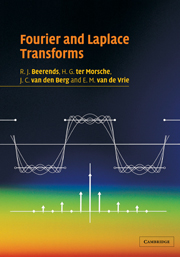Introduction
Published online by Cambridge University Press: 05 June 2012
Summary
Fourier and Laplace transforms are examples of mathematical operations which can play an important role in the analysis of mathematical models for problems originating from a broad spectrum of fields. These transforms are certainly not new, but the strong development of digital computers has given a new impulse to both the applications and the theory. The first applications actually appeared in astronomy, prior to the publication in 1822 of the famous book Théorie analytique de la chaleur by Joseph Fourier (1768 – 1830). In astronomy, sums of sine and cosine functions were already used as a tool to describe periodic phenomena. However, in Fourier's time one came to the surprising conclusion that the Fourier theory could also be applied to non-periodic phenomena, such as the important physical problem of heat conduction. Fundamental for this was the discovery that an arbitrary function could be represented as a superposition of sine and cosine functions, hence, of simple periodic functions. This also reflects the essential starting point of the various Fourier and Laplace transforms: to represent functions or signals as a sum or an integral of simple functions or signals. The information thus obtained turns out to be of great importance for several applications. In electrical networks, for example, the sinusoidal voltages or currents are important, since these can be used to describe the operation of such a network in a convenient way.
- Type
- Chapter
- Information
- Fourier and Laplace Transforms , pp. 1 - 4Publisher: Cambridge University PressPrint publication year: 2003



